Super Mario Bros. 2 was the first game that I remember being a big deal for me to get. I got it in the spring of 1989, either as a gift for Easter or First Holy Communion — I don’t remember which. I do remember that I had to share it with my sisters, so it was really only one-third mine. It’s been almost exactly 30 years, so I’m forgiving myself for the shaky memory. As I started planning to write about this game, it became clear to me that a few of the things I thought I knew about this game weren’t entirely accurate.
I remember quite clearly that I owned a copy of the issue of Nintendo Power with it on the cover. That issue, with the cover featuring the unforgettable clay sculpture of Wart chasing Mario across Subcon, was dated July/August 1988, but I didn’t even get a Nintendo until Christmas of that year. SMB2 was released on October 9, 1988, which frankly, blows my mind because it had always seemed like it was a new release when I got it. I don’t know when or where I got that copy of Nintendo Power, but it definitely wasn’t when the magazine was new.
It turns out that I got this game about six months after it was released, which as things go, isn’t exactly old. Christmas 1988 is when most of my friends seemed to get an NES, and I may have been the first of my friends to get this game. The only time I remember playing it before I got it myself was at Children’s Palace on a PlayChoice-10. I remember being extremely hyped for this game, something I’m sure that copy of Nintendo Power played no small part in.
The PlayChoice-10 was like a gateway drug. It always had a few games that none of my friends had, and it looked better than any NES on a TV. All the games on it just seemed to jump right off the screen. The effect was so dramatic that for years, I thought I had been playing a different version of the game. It turns out the game was exactly the same, but the hardware had important differences.
The single most important difference between the PlayChoice-10 and a standard NES was the Picture Processing Unit, or PPU. The PPU in the PlayChoice-10 output an RGB signal directly to an RGB arcade monitor. At home on an NES, the best you could hope for was composite video, but you were much more likely to be playing through an RF switch. Every link in the chain between the motherboard and your eyes was optimized for the best possible quality. The difference can actually be pretty striking.

Super Mario Bros. 2: Nestopia vs. PlayChoice color palette
It’s probably not quite accurate to call the PlayChoice-10 a reference implementation for the NES, but it’s certainly the highest quality you could hope to see in those days. The Famicom color palette is a topic in itself, but the short version is that there is no canonical NES color palette. This might seem tangential to this game in particular, but it really set my expectations for what this game was going to be.
But what about the game?
Right from the start, it’s pretty obvious that this game is a huge leap over Super Mario Bros. Games in those days were light on story. The first Super Mario Bros. doesn’t tell you anything in the game. If you wanted to know anything other than the characters names, such as what the objective of the game even was, you had to consult the manual. Without the manual, you were just a guy murdering turtles for some reason. The manual for Super Mario Bros. did a fair job of explaining the gameplay, the enemies, and the point of jumping on all those turtles, but it wasn’t much to look at.
Super Mario Bros. 2 improved on this approach and added some things that probably weren’t possible when SMB1 was released in 1985. The manual is a huge improvement — the enemies don’t look like they’re drawn on an Etch-a-Sketch — and the story is much more fleshed out. The text is also a much better translation from Japanese than SMB1. When you pop the game in, rather than starting on a silent title screen, you’re greeted with carnival music, and after a few seconds, a brief version of the story that was presented in the manual. It’s a much more polished presentation, making the entire experience feel about as immersive as a game possibly could in those days. Mario has been through many iterations, but the difference is nearly as striking as the transition from the 2D SNES to the 3D N64. This was the first time that the Mario of the game looked like the Mario featured in the manuals, arcade cabinets, and merchandise.
World 1-1 of Super Mario Bros. 2 stands as one of the greatest tutorial levels ever made. This level introduces nearly every mechanic the game has to offer. In the story told in the manual and on the title screen, The gameplay picks up exactly where the story from the manual and the title screen leave off — Mario climbs a stair and opens a door. On the other side of that door is… nothing!
The game introduces you to vertical scrolling before you even press a button during gameplay. This is followed by enemies that you can’t defeat by jumping on. You then learn that to get anything done in this world, you have to pick up and throw things. You get to see areas that wrap around when you walk off the edge, as well as a door to enter. All this is before you really even enter the level.
On the other side of that door are climbing vines, potions, coins, mushrooms, POW blocks, hearts, moving platforms, cherries, star power, 1-ups, turtle shells, bombs, and stop watches. This world even introduces basic strategy mechanics with the first branching path. If you take the back route to Birdo, you learn that your character can leave the top of the screen to go over obstacles.
Some of the things introduced in 1-1, like POW blocks, turtle shells, and 1-ups aren’t terribly common as the game progresses, but the very first level lets you know how they work. The game eventually introduces new challenges — whale spray that can lift you up but harm you if you’re not careful, slippery ice, and increasingly annoying enemies — but it builds up to these things. You get a little bit of all the important stuff right from the start.
Beyond the first world, the game keeps you on your toes. Each world feels unique — much more so than in Super Mario Bros. Other than the two underwater levels, the original SMB didn’t add many new things as you progressed. Don’t get me wrong, Super Mario Bros. is a classic that I love it every bit as much as SMB2, but it feels more like a race to the end than a place you can explore.
What’s missing
The things this game had, as well as the things it didn’t have, help to cement SMB2’s status as the odd one out in the series. The lack of a countdown timer gives you freedom to explore and try new things. If you didn’t hit the wall behind the waterfall with bombs, you could just exit through the door and keep trying.
The lack of a score is also no problem. Scores on platformers always seemed like a holdover from arcade games. In an arcade, where the idea is to get you to part with as many quarters as possible, the ability to enter your initials alongside your score was the closest thing to an accomplishment you could hope for. But when you’re playing a game on a home console, accomplishment is measured in real progress. Nobody cared that this game didn’t have a score or a countdown clock because there was a real chance that you could actually beat the game. It’s not like the NES saved your scores anyway.
There are other things missing from this game that players may have been expecting. While we did get mushrooms and stars, those were the only power-ups in the game. None of those things you could pull out of the ground granted Mario and his friends any special powers. Mario games didn’t go power-up crazy until Super Mario Bros. 3, so it wasn’t that weird at the time. The game also features a distinct lack of things to jump into and smash. The only bricks in the game are walls and floors in a few levels, and there’s not a question block to be found. There are coins, but they’re only found in subspace, and instead adding up to an extra life, they give you chances at the slot machine bonus game. The lack of an on-screen display means the only time you can see how many lives and coins you have is between levels or when you die.
A game in disguise
With so many standard Mario things lacking, and plenty of un-Mario things included, it’s almost as if Super Mario Bros. 2 isn’t really a Mario game at all. Of course, if you’re reading this, there’s a pretty good chance you already know the story. It’s actually not a Mario game. SMB2 started out in Japan as Yume Kōjō: Doki Doki Panic.
The usual story is that the real SMB2, which we eventually got as The Lost Levels on Super Mario All-Stars, was deemed to be too difficult for American players. If you think for a moment about the average difficulty of a game on the NES, “too hard to release” seems like a pretty absurd excuse. The Lost Levels was difficult, but not that difficult compared to most NES games. The real excuse is much more boring: The game was just too similar to SMB1. The original Japanese SMB2 introduced a few new game mechanics, such as wind and Luigi’s jumping ability, but for the most part it was a continuation of SMB1. The graphical differences weren’t even improvements, they really were just slightly different. One small difference I do appreciate is that on some levels, it is finally possible to do what every kid had a friend who claimed they could do in SMB1: Jump over the flagpole at the end of the level. You might not be glad you did, however.
If you can locate a copy of Doki Doki Panic, it’s worth checking out to see the little differences. The characters and story are obviously different, but many of the changes are more subtle. The American game includes lots of small animations that the original lacks, which makes for a more polished feel overall. The characters can’t run, which makes choosing which one to use much more important. There are places that some characters just can’t get to in Doki Doki Panic.
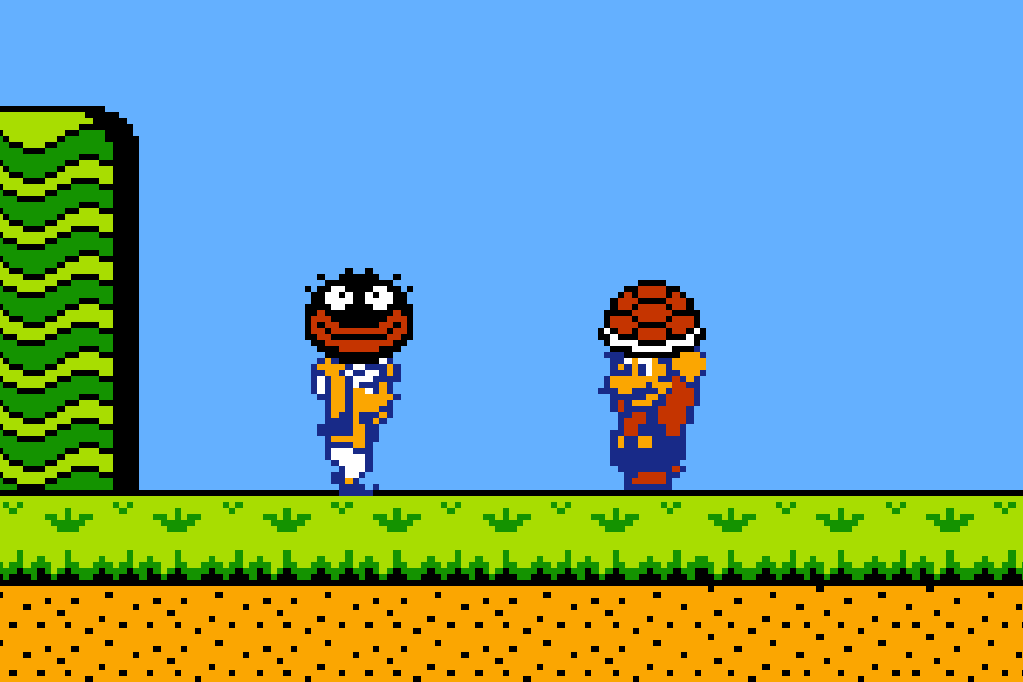
Problematic!
In SMB2, you don’t have to switch characters if you don’t want to. To beat Doki Doki Panic, you effectively need to beat it four times — once with each character. The characters can’t tag in and out like in SMB2 — in Doki Doki Panic, you can only switch between worlds, and if you do, you start back at the beginning, or wherever you left off with that character. It’s a system that worked on the Famicom Disk System that just wasn’t feasible on the NES. The story of how Doki Doki Panic came to exist, and how it became SMB2 is a bigger story than I can cover today, but it’s a fascinating bit of video game history.
A (mostly) dead end
Even though the SMB2 we got is regarded as a classic game of its era, it soon became clear that Nintendo never intended it to be the direction forward for the franchise. Super Mario Bros. 3 immediately took us back to collecting coins, stomping on goombas, and chasing Bowser across the Mushroom Kingdom to rescue the princess. With the exception of ports of SMB2 to other Nintendo systems, and one weird add-on level for the Game Boy Advance version of SMB3, Mario never pulled another vegetable out of the ground. A few enemies such as Bob-omb and Shy Guys still make regular appearances in Mario games, but the main villain, Wart, has only had a role in one game since then, and is was under his Japanese name in a Zelda game.
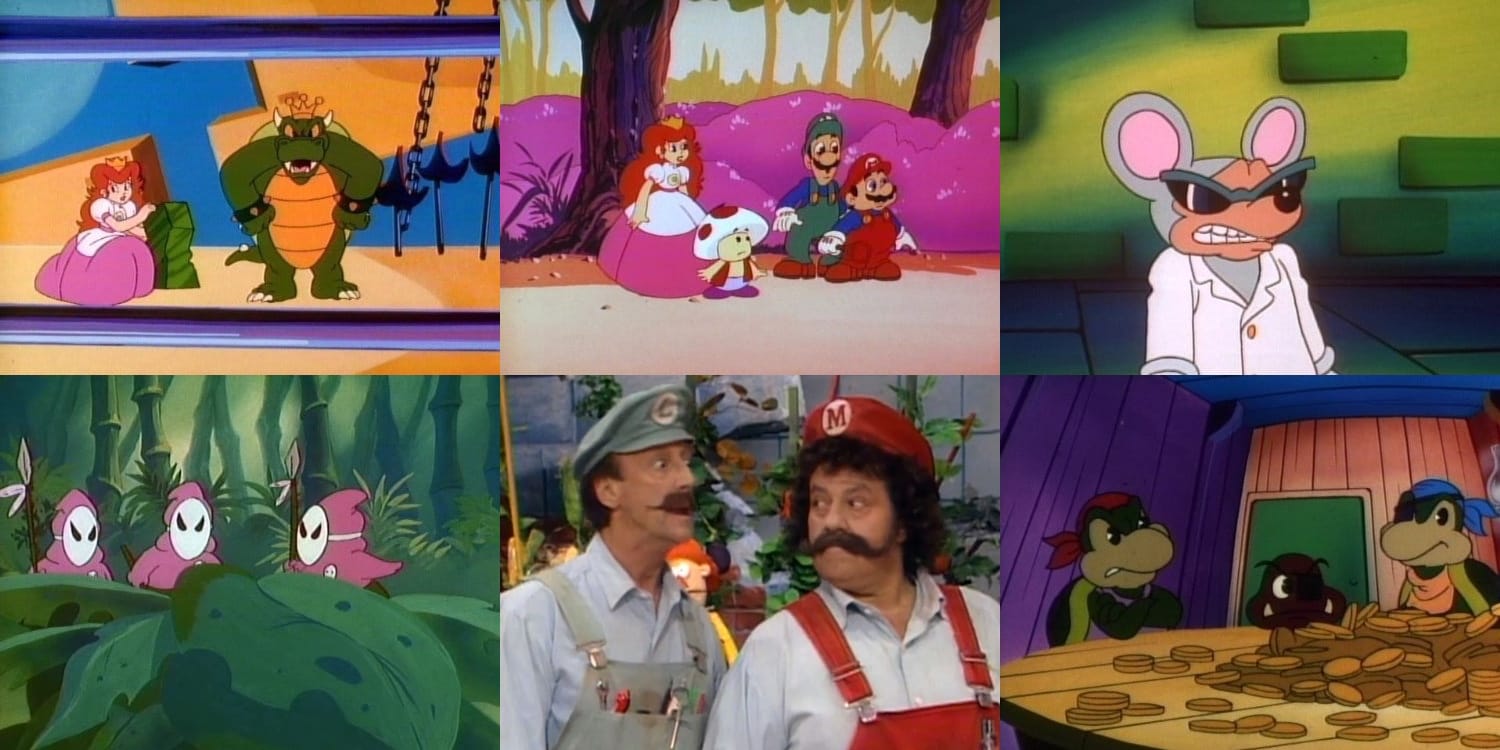
Screenshots from the Super Mario Bros. Super Show
SMB2 wasn’t a complete dead end, however. It was released when Nintendo was quickly saturating all media, including the TV airwaves. The Super Mario Bros. Super Show! came on the air in 1989, when SMB2 was the most current Mario release. King Koopa was the main antagonist, but the show was mostly based on elements directly from SMB2. Wart, however, was nowhere to be seen. Enemies from the original Super Mario Bros. appeared on the show, but nowhere near as frequently as enemies from SMB2, including bosses like Fryguy and Mouser. Mario, Luigi, Toad, and the Princess were were all featured characters in the animated segments, just like in the game.
Once SMB3 was released, however, The Adventures of Super Mario Bros. 3 began airing on Saturday mornings, and it featured mostly elements from the new game.
Random thoughts
The fact that all four playable characters have different attributes makes the need for great controls necessary. Like most Mario games, it never feels cheap when you get hit by an enemy. Collision detection is another improvement over Doki Doki Panic. It can be frustrating trying to collect cherries in Doki Doki Panic because it seems like the character’s hitbox only covers the lower half of the sprite.
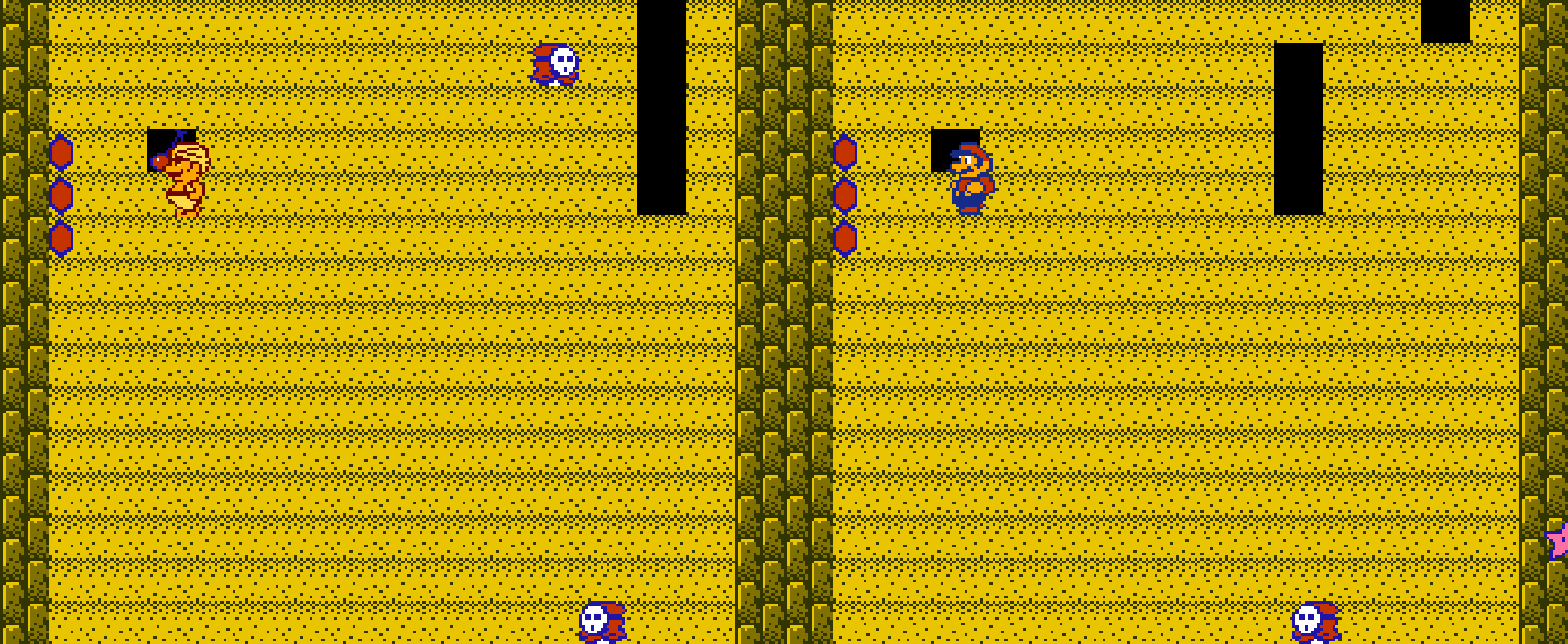
Doki Doki Panic has pretty weird hit detection on some objects.
Super Mario Bros. 2 holds up visually as one of the best games on the NES, despite essentially being a 1987 game. I certainly think it looks better in many respects than SMB3, which often seems drab and washed out compared to this game. SMB3 also makes a lot of graphical tradeoffs in order to allow for some different capabilities. The character sprites and subtle animations in this game make it seem much less stiff than SMB3.
The shortness of this game is also hard to ignore. The original Super Mario Bros. has 32 levels, but SMB2 has only 20. The game packs a lot of variety into those 20 levels, which helps it avoid getting repetitive, despite a few bosses showing up more than once. Nintendo overcorrected here with SMB3, which, while containing lots of variety, still gets extremely repetitive by the end. Most people will use a few warp zones, but if you actually try to play through, it gets tedious after 90 levels.
Also in this issue
I originally said I’d be playing the games featured on the old issues of Nintendo Power, so let’s do a quick dive into what was exciting in the world of Nintendo in the summer of 1988.
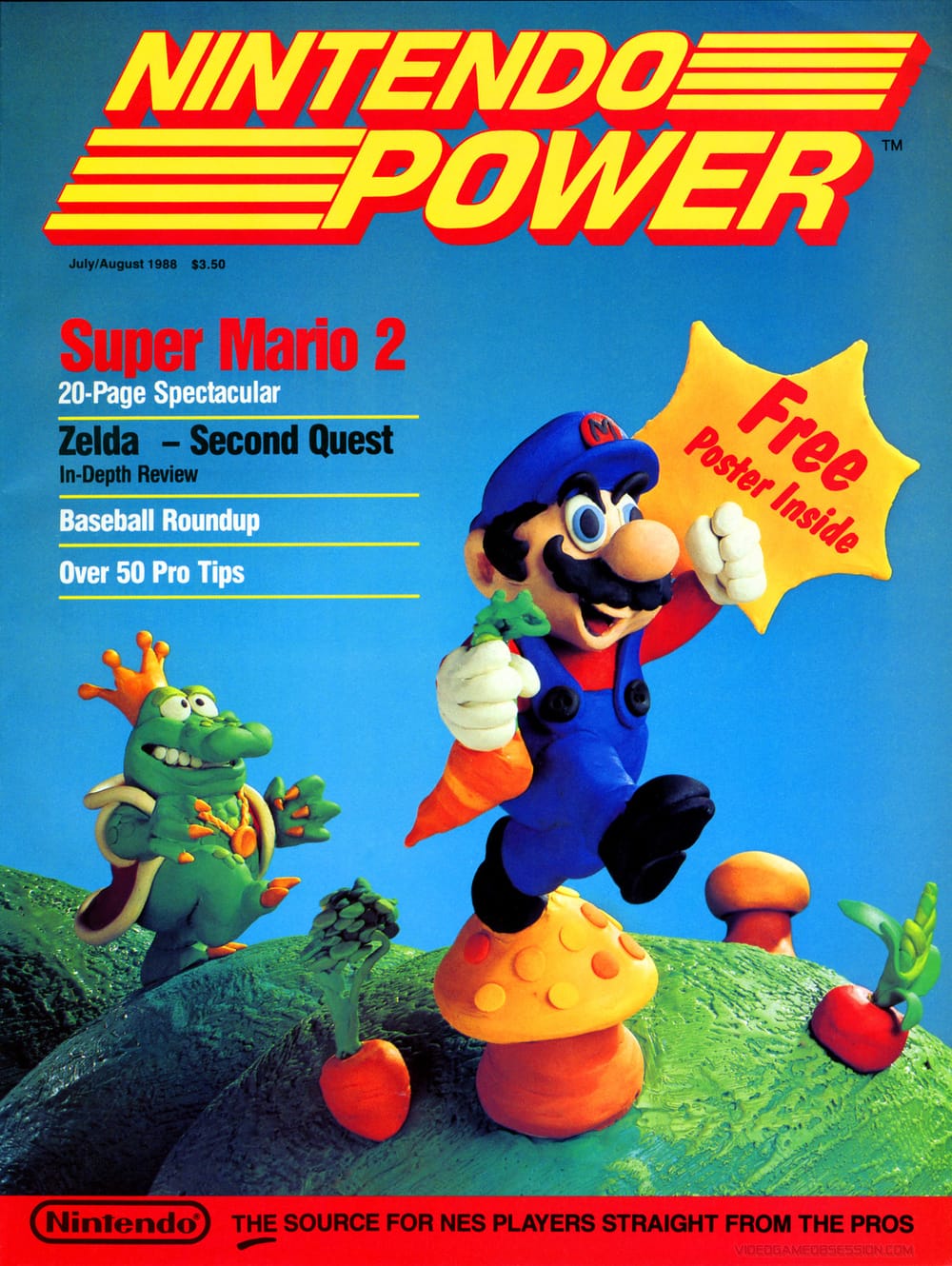
Super Mario Bros. 2
We’ve been over the game, but how did Nintendo Power cover it? The SMB2 feature is huge but it doesn’t cover that much of the game. It really tells you all about the mechanics and how to play, but the maps only go up to World 2-3. Remember, Nintendo was being extremely strategic with the release of this game. The nature of the coverage of the game indicates that they really wanted to really prepare players for something different.
I was struck by the appearance of the character illustrations in the feature. Nintendo tightly controls how its characters appear these days, but their appearance is all over the map in this spread. Some of the art style is extremely Japanese, while some is clearly more tailored for American audiences.
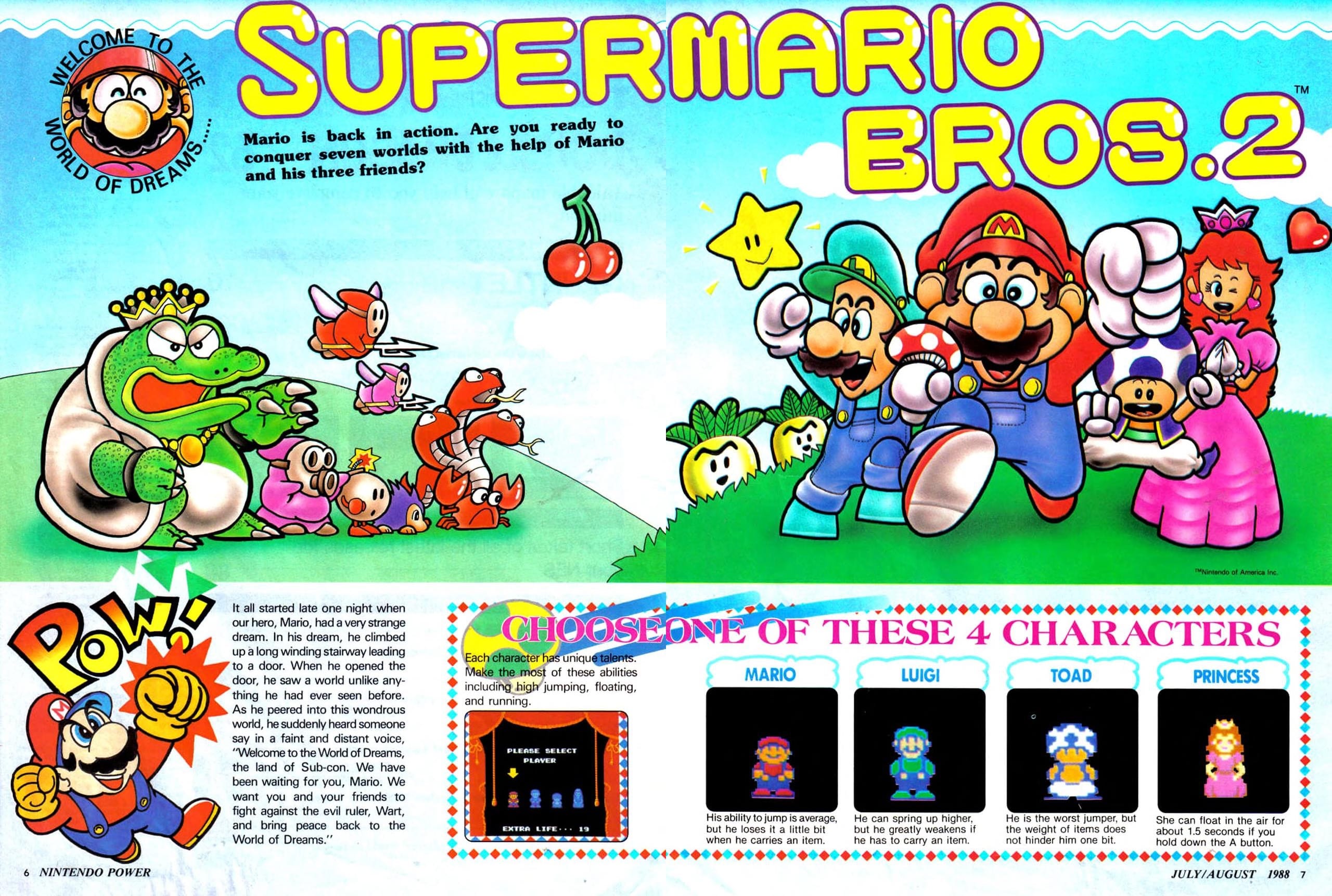
Nintendo Power
I love the styles of these illustrations. Nintendo would never allow something like this today.
None of it appears to be created specifically for this issue. It’s completely inconsistent and fun in a way Nintendo would never allow today. I love the manga style of the drawings, and I wish they kept it. It probably wouldn’t have played well with the American audiences they were very delicately trying to please, but it’s fun to think about.
The Legend of Zelda
The feature on The Legend of Zelda’s second quest is pretty great. It covers the entire overworld and the first six labyrinths, and even tells you how to skip straight to the second quest. It covers a ton of material that you wouldn’t have been able to find elsewhere. If you manage to sit a kid down in front of any of these games, don’t try to make it seem like the lack of Google made these games impossible to figure out. It’s only fair to send them in equipped with guides like this.
Baseball round up
It’s hard to believe there was actually three baseball games for the NES by this point in 1988. RBI Baseball had the endorsement of the Major League Baseball Players Association, so it used real player names, but the teams were referred to only by their cities. Major League Baseball was licensed by the league, so it could use team names, but not the players’ names. Bases Loaded didn’t have the endorsement of either, but it was the best looking of the three, and you could charge the mound if you were hit by a pitch. It even had voices, which was really ahead of its time.
Double Dragon
If you’re into low-speed fights, the Double Dragon feature covers most of the game. It’s not exactly a game where you can get lost, but maps were always fun. It’s got some nice information on the gameplay, but this was a game where staying alive was the only strategy you needed.
Highlights from Counselor’s Corner and Classified Information
- Somehow, they crammed half the map for Metroid, along with locations of items, onto one page. Not bad.
- They covered the unlimited 1-up trick in Super Mario Bros. where you hop on a Koopa shell on the stairs in 3-1. I discovered this once by accident and I’ve never been able to do it again.
- If you want to beat Mike Tyson, they had you covered. This was hard even if you knew the tricks. I admit that I’ve still never beaten Tyson, despite having the code memorized for over 30 years.
- Right here, in the very first issue of Nintendo Power, they just give you the Konami Code for Contra. I don’t know if this was common knowledge yet by this point, but it wasn’t long before everyone with an NES had this memorized.
- If you were interested in fighting the same boxers in a different order, in a different colored ring, there’s a super secret code for Mike Tyson’s Punch Out!! that takes you to Another World Circuit.
Now Playing
The Now Playing feature covered all the new releases out now, or that will be out by the time the next issue comes out. This had to get unsustainable at some point.
- The Gauntlet feature covers the basics and includes four maps (out of 100). I rented this game once and found it vaguely fun.
- They get into the basics for Contra. Like Double Dragon, it’s another game where the objective is to not die. Instead of all the enemies moving slowly, they move at a normal speed.
- Wheel of Fortune and Jeopardy were exactly what it sounded like. They weren’t bad, but text entry on the NES controller was always extremely tedious.
Pak Watch and Video Shorts
These both covered upcoming releases. Some highlights: Rambo, Metal Gear, Bionic Commando, Golgo 13, Zelda II: The Adventure of Link, Blaster Master, Castlevania II: Simon’s Quest, Marble Madness, Life Force, California Games, and my favorite, the game that spawned a Simpsons gag, Lee Trevino’s Fighting Golf.
Random bits
I think it’s pretty clear that Nintendo Power was absolutely jam-packed in those days. I’m leaving out more than I’m describing, but I have two completely random things that I want to mention.
- If you removed everything having to do with video games from this magazine and handed it to a random person on the street, there’s a good chance they could peg this as being published in mid-1988 based entirely on the celebrity interview with Kirk and Candace Cameron.
- In both the front and back of the magazine are ads for Nintendo Power subscriptions. In these ads are pictures of this very magazine. If you look closely, you can see that they’re not quite the same. The real cover features a clay model of Wart and Mario, but the magazines in the ads contain mockups of the real cover. Each one is slightly different, providing a small window into the process of creating this magazine.
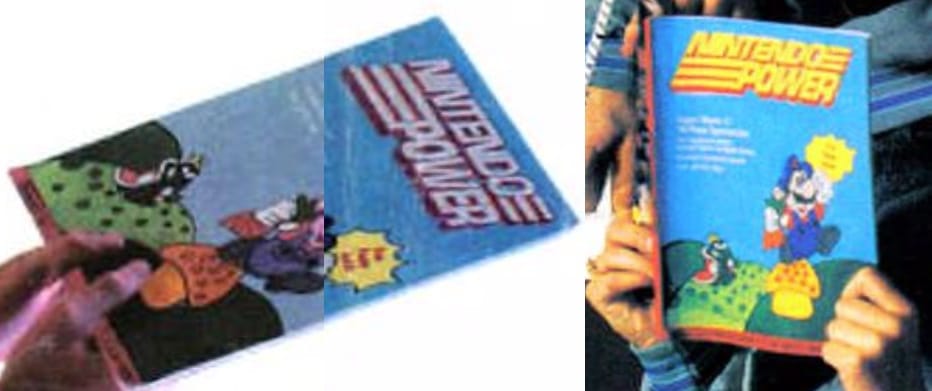
Early versions of the cover of Volume 1 of Nintendo Power.
And finally
Super Mario Bros. 2 is both a classic and an oddity. It is a dead end, and a defining moment in the series. It was the product of a time when the elements of a Mario game had yet to be firmly established. It’s fun to think about what might have been, had Nintendo gone further down this path.
Super Mario Bros. 2 is a pretty important game to me, so this post is more of a very special entry than I think most will end up being. Most of the Nintendo Power cover games aren’t important to me at all, which is why I invented an excuse to play them. I want to experience them, even if I don’t end up loving them.
Next in the series is a game I’ve got plenty of experience playing for 45 minutes and then giving up on: Castlevania II: Simon’s Quest!
